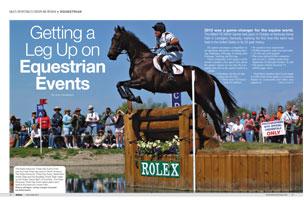
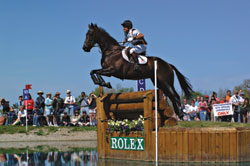 2010 was a game-changer for the equine world.
2010 was a game-changer for the equine world.
The Alltech FEI World Games took place in October at Kentucky Horse Park in Lexington, Kentucky, marking the first time this event was held in the United States in its 20-year history.
The Games encompass competition in all equestrian disciplines, including Reining, Endurance, Dressage, Eventing, Para Dressage, Vaulting and Driving.
Those unfamiliar with equine events should consider a few quick facts about the Games' impact on not only the Lexington area, but on the equine world as a whole:
Attendance for the six-day event was 507,022
There were 752 horses with 632 athletes
58 countries were represented
20,000 temporary seats were provided
112,368 cars were parked
The event utilized 6,000 volunteers and served 1.1 million meals from September 25 through October 10, and
The Games website received 7.6 million page views.
(And those numbers don't even begin to reflect hotel room nights, or economic impact to restaurants and other area suppliers).
According to the California Equestrian Park and Event Center in Sonoma, California, a World Cup event typically brings $150 million to a region. The 2006 World Equestrian Games in Aachen, Germany brought $311 million to that country, and Kentucky's generated $157 million here. The American Horse Council's Economic Impact of the Horse Industry reports that the resulting effect on the gross domestic product for the recreation industry is $32 billion.
It was a big deal.
John Nicholson, executive director of the Kentucky Horse Park, is also the president of the World Equestrian Games 2010 Foundation, an organization created to organize and conduct the 2010 Alltech FEI World Equestrian Games.
"It was historic and a total game changer for our community and state in equestrian sport," said Nicholson. "The park had been growing for several years but as a result of the urgency of the World Games, we were able to secure $80 million in capital investments."
The investments allowed KHP to build both a 6,000 square foot climate controlled indoor arena and a new 7,500 seat outdoor stadium, to upgrade roads and pathways, and to create the temporary accommodations the Games would require.
"We knew two things going into the FEI," said David Lord, President of the Lexington Convention and Visitors Bureau. "We would get state money to improve the facility and of course, press coverage for the event."
The World Games were the largest sporting event ever held in Kentucky. "We received eight hours of prime time coverage on NBC over three weekends," said Nicholson. "That is unprecedented and was a major step forward for the profile of equestrian sports in the United States and North America."
"The event itself is similar to hosting the Olympics for Lexington," Nicholson continued. "There was a real synergy between the park and downtown Lexington, which went through a dramatic renovation. As a result, there is great vitality."
"There is even more than the impact of the investment and the people who came for those 16 days," said Lord. "This whole arena of sport horses is burgeoning. We are starting to see more dressage and horse jumping, and it's making a big difference. That kind of impact doesn't show up on the radar screen."
"The events tend to be family involved," he added. "The average is three to four people for every horse: parents, trainers or groomers. Obviously, the more attendees we have as a result of each entrant, the greater the economic impact, and that has an effect on the community from whether it's somebody who may want to move an operation here or just do more business. People get exposed to the area; they like it and tend to come back."
It's A Small World
The title is not only an attraction at Disney World and one of those songs you just can't get out of your head, it's also the equine community. Like most social and professional circles, it can seem like a small world. Equestrian facility staff, event planners, trainers and athletes form a close-knit circle of people who look out for one another.
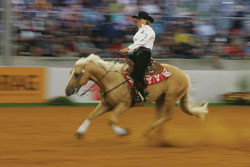 "There is competition among facilities that can host events," said Nicholson. "It's friendly competition, because you want to create circuits and what we don't want is for someone to be unsuccessful. A lot of people who are passionate about equine sports will compete in Florida in the winter and Kentucky in the spring and summer. We have a very symbiotic relationship."
"There is competition among facilities that can host events," said Nicholson. "It's friendly competition, because you want to create circuits and what we don't want is for someone to be unsuccessful. A lot of people who are passionate about equine sports will compete in Florida in the winter and Kentucky in the spring and summer. We have a very symbiotic relationship."
Tim Lynch is the General Manager of the Horseshoe Park Equestrian Centre in Queen Creek, Arizona and has over 30 years in the equestrian industry, 25 of them as a horse trainer.
"You really do cheer for your competitors," he said. "I recommend that you truly understand your market. The key is to get the professionals to organize the event and the people who understand the industry."
"I think the markets may change a little bit, but the industry itself without a doubt is continuing to grow," said Lynch.
In 1917 the United States Equestrian Federation was formed and is the country's largest multi-breed equestrian organization with over 91,000 members. The United States Eventing Association and the United States Equestrian Team Foundation partner with one another to promote equine events, and boast 14,000 members and organize over 280 annual competitions.
There are currently 28-30 equine associations in and approximately 400 horse farms in the Lexington area. The University of Kentucky is conducting a study on the equine industry as a business cluster. "It will show just how intertwined the industry is," said Lord.
Bluegrass, Footings and Stalls
The Horseshoe Park Equestrian Centre has been in operation for just three years, but is quickly making its mark.
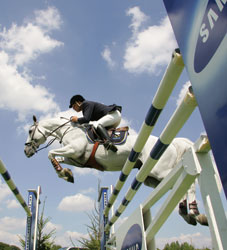 "We are a very versatile facility and we have a wide variety of disciplines," said Lynch. "We have 400 stalls and four arenas. Being a brand new place, there are a lot of amenities and basic needs that have recently become industry standards that we can meet. We have two show arenas and two warm-up arenas that are high-quality enough to be show arena themselves. We've invested $250,000 into the sound system and can broadcast into each arena individually or across all arenas, barns and parking lots. We also have wifi throughout the park which is a new technology to our fans."
"We are a very versatile facility and we have a wide variety of disciplines," said Lynch. "We have 400 stalls and four arenas. Being a brand new place, there are a lot of amenities and basic needs that have recently become industry standards that we can meet. We have two show arenas and two warm-up arenas that are high-quality enough to be show arena themselves. We've invested $250,000 into the sound system and can broadcast into each arena individually or across all arenas, barns and parking lots. We also have wifi throughout the park which is a new technology to our fans."
With the expansion of Kentucky Horse Park, the facility showcases the new 6,000 square foot climate controlled arena and also offers 1,424 stalls. "It's about the comfort and care of the athletes," explains Nicholson. "In this case, the athletes are horses. The stalls have to be plentiful and in great shape. Then you get into the competition facilities. They talk about footing the way theologians talk about scripture. You can have the most beautiful, sophisticated facility but if your footing isn't good, then you have a worthless facility."
(Primer for the uninitiated: footing refers to the surface under the horse's hooves, and as with any sport, a good surface can make all the difference in the world).
"The key thing to understand when you pick an event is the kind of ground you need for that event," Lynch agrees. "The kind of water and composition is so integral to success. The ground is imperative. Every type of discipline has very specific requirements and that can be not only a safety factor but a defining performance factor."
Not all events are designed to attract world renowned events, but can be acceptable for local and regional competitions. Enumclaw Expo Center, located in the foothills of Mt. Rainier in Washington, is a 72-acre park that has experienced measurable success with 4-H events.
"We are trying to get more equestrian events at our venue," said Kristen Damazio. "Our barn has new 10' x 12' matted stalls that are in very close proximity to the covered arena, rodeo arena and two warm-up arenas. We can also accommodate a large number of RVs in our parking lot or even on our grounds."
Another benefit? The aesthetics of the Expo Center. "We have reasonable pricing, quality service and easy access to the venue," said Damazio. "But the Expo Center is a picturesque facility; it is not all concrete and buildings."
Locating the right venue for your event and discipline can be a daunting task, but there are ample resources online that can assist your search for equine venues and show facilities; these include O Horse!, an international horse directory, as well as the horse website, equisearch.com.
Disciplines and Events
Chances are the most recognizable events to those outside of the equine world are found within thoroughbred racing. The quest for the Triple Crown (including the Kentucky Derby, Preakness Stakes and Belmont Stakes) is a major attraction for fans of all walks of life, even those who have never ridden a horse.
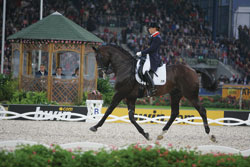 While some facilities make their mark within specific disciplines, others try to accommodate all of them and some equestrian events don't incorporate a type of discipline at all.
While some facilities make their mark within specific disciplines, others try to accommodate all of them and some equestrian events don't incorporate a type of discipline at all.
In Thomson, GA, the 45th Annual Belle Mead Fox Hunt took place in November. "It's the largest opening meet for a sport like that in the world," said Elizabeth Vance, Executive Director of Thomson-McDuffie Tourism. "From early November until late March, they hunt and the event brings people from all over the world. There are 11 different countries represented and hundreds of riders."
"Aside from the hunt, we are a horse community," said Vance. "Pine Top Farm was a site for equestrian training during the Atlanta Olympics in 1996." The facility also hosts eventing in the spring and fall.
Pine Top Farms include facilities with dressage arenas and cross country courses as well as permanent event stabling for 150 horses.
Versatility and flexibility are the keys to attracting equestrian events.
"We host a number of events," said Lynch. "We have a finely tuned operations crew and can use the entire facility for a week or better and in 48 hours, we can set up for an entirely different discipline. We have seven months of activity, with 180 events. We have some great covered facilities and can provide a 20-degree difference in our dry climate. There are also some planners who are interested in doing some evening hunter jumping events in the summer."
Kentucky Horse Park hosts 75 different equestrian events, some which might last for up to three weeks, but it also capitalizes on the facility itself. "We also do a lot of things like clinics and a lot of education," said Nicholson. "We are in the tourism business and the competition business, so we battle the calendar and the time of year."
"One of the things we were able to do with the 6,000 square foot arena is Western sport," continued Nicholson. "That is going to be increasingly prevalent in Kentucky."
"Thoroughbred racing has been the bread and butter," added Lord. "On the show world, the diversification of the horse industry in Lexington is changing the game. We have a vested interest in the industry and how everyone is impacted."
Like any sporting event, the athletes are the main focus, and attracting those events is a goal for any destination with the right venues. Equestrian events could be your game changer.

